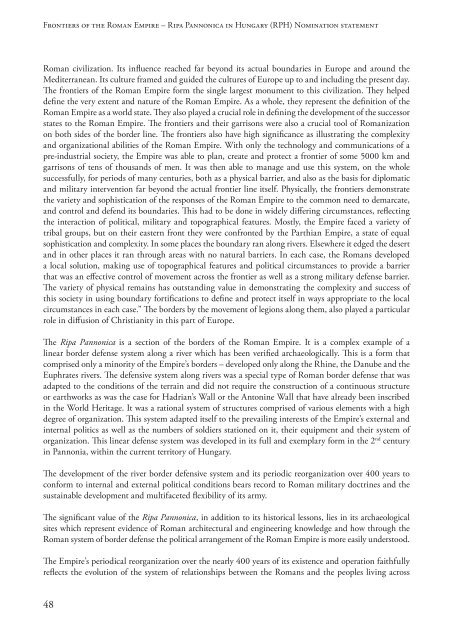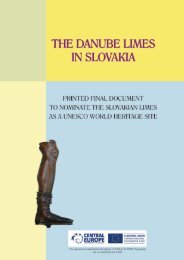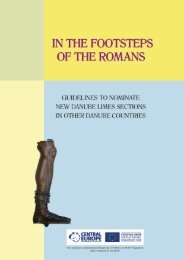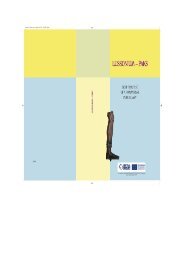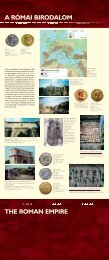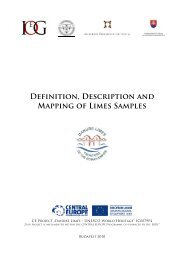the PDF version! - Danube Limes
the PDF version! - Danube Limes
the PDF version! - Danube Limes
You also want an ePaper? Increase the reach of your titles
YUMPU automatically turns print PDFs into web optimized ePapers that Google loves.
Frontiers of <strong>the</strong> Roman Empire – Ripa Pannonica in Hungary (RPH) Nomination statement<br />
Roman civilization. Its influence reached far beyond its actual boundaries in Europe and around <strong>the</strong><br />
Mediterranean. Its culture framed and guided <strong>the</strong> cultures of Europe up to and including <strong>the</strong> present day.<br />
The frontiers of <strong>the</strong> Roman Empire form <strong>the</strong> single largest monument to this civilization. They helped<br />
define <strong>the</strong> very extent and nature of <strong>the</strong> Roman Empire. As a whole, <strong>the</strong>y represent <strong>the</strong> definition of <strong>the</strong><br />
Roman Empire as a world state. They also played a crucial role in defining <strong>the</strong> development of <strong>the</strong> successor<br />
states to <strong>the</strong> Roman Empire. The frontiers and <strong>the</strong>ir garrisons were also a crucial tool of Romanization<br />
on both sides of <strong>the</strong> border line. The frontiers also have high significance as illustrating <strong>the</strong> complexity<br />
and organizational abilities of <strong>the</strong> Roman Empire. With only <strong>the</strong> technology and communications of a<br />
pre-industrial society, <strong>the</strong> Empire was able to plan, create and protect a frontier of some 5000 km and<br />
garrisons of tens of thousands of men. It was <strong>the</strong>n able to manage and use this system, on <strong>the</strong> whole<br />
successfully, for periods of many centuries, both as a physical barrier, and also as <strong>the</strong> basis for diplomatic<br />
and military intervention far beyond <strong>the</strong> actual frontier line itself. Physically, <strong>the</strong> frontiers demonstrate<br />
<strong>the</strong> variety and sophistication of <strong>the</strong> responses of <strong>the</strong> Roman Empire to <strong>the</strong> common need to demarcate,<br />
and control and defend its boundaries. This had to be done in widely differing circumstances, reflecting<br />
<strong>the</strong> interaction of political, military and topographical features. Mostly, <strong>the</strong> Empire faced a variety of<br />
tribal groups, but on <strong>the</strong>ir eastern front <strong>the</strong>y were confronted by <strong>the</strong> Parthian Empire, a state of equal<br />
sophistication and complexity. In some places <strong>the</strong> boundary ran along rivers. Elsewhere it edged <strong>the</strong> desert<br />
and in o<strong>the</strong>r places it ran through areas with no natural barriers. In each case, <strong>the</strong> Romans developed<br />
a local solution, making use of topographical features and political circumstances to provide a barrier<br />
that was an effective control of movement across <strong>the</strong> frontier as well as a strong military defense barrier.<br />
The variety of physical remains has outstanding value in demonstrating <strong>the</strong> complexity and success of<br />
this society in using boundary fortifications to define and protect itself in ways appropriate to <strong>the</strong> local<br />
circumstances in each case.” The borders by <strong>the</strong> movement of legions along <strong>the</strong>m, also played a particular<br />
role in diffusion of Christianity in this part of Europe.<br />
The Ripa Pannonica is a section of <strong>the</strong> borders of <strong>the</strong> Roman Empire. It is a complex example of a<br />
linear border defense system along a river which has been verified archaeologically. This is a form that<br />
comprised only a minority of <strong>the</strong> Empire’s borders – developed only along <strong>the</strong> Rhine, <strong>the</strong> <strong>Danube</strong> and <strong>the</strong><br />
Euphrates rivers. The defensive system along rivers was a special type of Roman border defense that was<br />
adapted to <strong>the</strong> conditions of <strong>the</strong> terrain and did not require <strong>the</strong> construction of a continuous structure<br />
or earthworks as was <strong>the</strong> case for Hadrian’s Wall or <strong>the</strong> Antonine Wall that have already been inscribed<br />
in <strong>the</strong> World Heritage. It was a rational system of structures comprised of various elements with a high<br />
degree of organization. This system adapted itself to <strong>the</strong> prevailing interests of <strong>the</strong> Empire’s external and<br />
internal politics as well as <strong>the</strong> numbers of soldiers stationed on it, <strong>the</strong>ir equipment and <strong>the</strong>ir system of<br />
organization. This linear defense system was developed in its full and exemplary form in <strong>the</strong> 2 nd century<br />
in Pannonia, within <strong>the</strong> current territory of Hungary.<br />
The development of <strong>the</strong> river border defensive system and its periodic reorganization over 400 years to<br />
conform to internal and external political conditions bears record to Roman military doctrines and <strong>the</strong><br />
sustainable development and multifaceted flexibility of its army.<br />
The significant value of <strong>the</strong> Ripa Pannonica, in addition to its historical lessons, lies in its archaeological<br />
sites which represent evidence of Roman architectural and engineering knowledge and how through <strong>the</strong><br />
Roman system of border defense <strong>the</strong> political arrangement of <strong>the</strong> Roman Empire is more easily understood.<br />
The Empire’s periodical reorganization over <strong>the</strong> nearly 400 years of its existence and operation faithfully<br />
reflects <strong>the</strong> evolution of <strong>the</strong> system of relationships between <strong>the</strong> Romans and <strong>the</strong> peoples living across<br />
48


